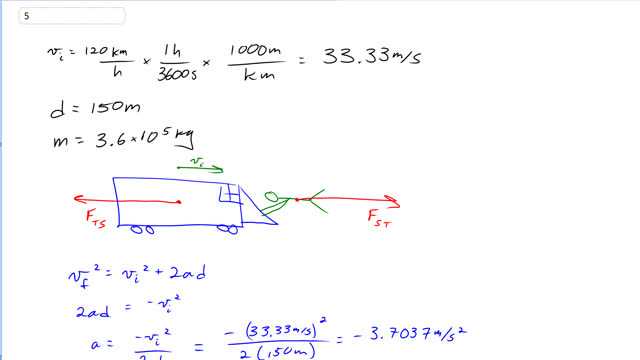
Superman must stop a 120-km/h train in 150 m to keep it from hitting a stalled car on the tracks. If the train’s mass is , how much force must he exert? Compare to the weight of the train (give as %). How much force does the train exert on Superman?

In order to watch this solution you need to have a subscription.
This is Giancoli Answers with Mr. Dychko. We'll take care of some bookkeeping work first by changing this velocity intermediate per second. So, 120 kilometers per hour times 1 hour for every 3600 seconds makes the seconds end up on the bottom of the units and the hours cancel in times by a 1,000 meters per kilometer. You can also divide by 3.6, that's a shortcut for doing this. And you get 33.33 units per second the displacement of the train is gonna be 150 meters before it collides with some car that's over here. And the mass of the train is 3.6x10^5 kilograms. And here's a picture showing the Superman pushing on the train bringing it to a stop. So, this is the force on the train due to Superman. So, the first subscript labels the object that the force is on, and the second subscript labels the thing that's exerting the force. And likewise on Superman we have an arrow showing the force on Superman due to the train. And to enter Part C of this question, those forces are the same magnitudes but in opposite directions, these are Newton's third law pairs. And you can always identify third law pairs because the subscripts are the same just in different order. So, we can see from this free body diagram of the train although I didn't bother writing gravity in the normal force on here. Horizontally speaking, Superman exerts the only force that's on the train and so he exerts the net force. And we can calculate what that is by going mass times acceleration. So, first we need to find the acceleration of the train and here's a formula that contains only one unknown which is a, because we know that the final velocity is zero, the train comes to a stop, and we're given the initial velocity and its displacement. So, we'll subtract V initial squared from both sides. and then we get the next line and we'll divide both sides by 2d. And we get acceleration is negative initial velocity squared divided by two times displacement. So, we have negative of 33.33 m/s squared divided by two times 150 meters, that gives negative 3.7037 m/s squared. And so, the force exerted by on the train due to Superman is the net force as we mentioned, and so that's mass times acceleration. So, we have 3.6x10^5 kilograms times negative 3.73037 m/s squared. And that gives negative 1.3x10^6 Newtons is the force on the train due to Superman. And the negative sign just indicates the direction, it's to the left, where we've assumed that to the right is positive which is always what you assume if nothing has stated otherwise. And Part B is, what is the force exerted by Superman as a fraction or as a percentage of the weight. And so, we'll divide the force by mg so, we have 1.3x10^6 Newtons divided by 3.6x10^5 kilograms times 9.8 Newtons per kilogram. And times by hundred, turn into a percent, then we have 38%. And as mentioned before in Part C, the force exerted on Superman due to the train is the same magnitude force but in the opposite direction, so, that's to the right, 1.3x10^6 Newtons.
I guess I missed this in chapter 2, but why do we square the magnitude of the velocity when using the kinematic equation (when trying to solve for the acceleration, blue writing, 2 minutes 3 seconds in)? It's a mistake I keep making but I can't figure it out why.
Thanks so much for your help.
Wait, I figured it out. It was staring me right in the face - I had the wrong formula. Sorry, thanks!